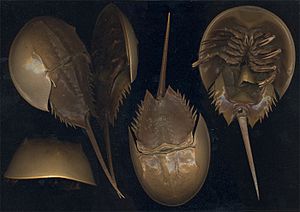Merostomata facts for kids
Quick facts for kids Merostomata |
|
|---|---|
 |
|
| Reconstruction of Eurypterus (Eurypterida) | |
 |
|
| Five views of Limulus polyphemus (Xiphosura) | |
| Scientific classification | |
| Kingdom: | |
| Phylum: | |
| Subphylum: | |
| Class: |
Merostomata
Woodward, 1866
|
| Orders | |
|
|
Merostomata is a special group of animals. It includes two main types: the amazing sea scorpions, which are now extinct, and the unique horseshoe crabs, which are still alive today! There are four different kinds of horseshoe crabs you can find living in the world right now.
A scientist named James Dwight Dana first used the name "Merostomata." He used it only for horseshoe crabs. Later, another scientist, Henry Woodward, decided to use the name for both sea scorpions and horseshoe crabs.
Contents
Sea Scorpions: Ancient Hunters
Sea scorpions, also known as Eurypterids, were ancient creatures. They lived in the oceans a very long time ago. These animals looked a bit like scorpions but lived in the water. They could grow to be quite large, with some types being over 2 meters (6 feet) long! Sea scorpions are now extinct, meaning they no longer exist on Earth.
Horseshoe Crabs: Living Fossils
Horseshoe crabs are not true crabs, even though they have "crab" in their name. They are more closely related to spiders and scorpions! These animals are often called "living fossils." This is because they have changed very little over millions of years. They look almost the same as their ancestors from ancient times.
What Makes a Horseshoe Crab Special?
Horseshoe crabs have a hard, helmet-shaped shell. This shell protects their bodies. They have ten legs, which they use to walk on the seafloor. They also have a long, pointy tail called a telson. They use their telson to flip themselves over if they get stuck upside down.
Where Do Horseshoe Crabs Live?
Today, horseshoe crabs live in shallow ocean waters. They are often found along coastlines. They spend most of their time on sandy or muddy bottoms. They eat small worms and clams.
Horseshoe Crab Life Cycle
Horseshoe crabs lay their eggs on beaches. The female digs a nest in the sand. She lays thousands of tiny eggs. Male horseshoe crabs then fertilize the eggs. After a few weeks, tiny horseshoe crab larvae hatch from the eggs. They look like mini versions of the adults. These young crabs grow by shedding their shells many times.
Images for kids
-
Mesolimulus from the Solnhofen limestone
See also
 In Spanish: Merostomados para niños
In Spanish: Merostomados para niños



